
The Turkana tribe of northern Kenya are buffeted by constant drought and food insecurity, which recent research says may be worsening due to climate change. Photo by: Rhett A. Butler.
Perhaps the most disconcerting thing about Halloween this year is not the ghouls and goblins taking to the streets, but a baby born somewhere in the world. It’s not the baby’s or the parent’s fault, of course, but this child will become a part of an artificial, but still important, milestone: according to the UN, the Earth’s seventh billionth person will be born today. That’s seven billion people who require, in the very least, freshwater, food, shelter, medicine, and education. In some parts of the world, they will also have a car, an iPod, a suburban house and yard, pets, computers, a lawn-mower, a microwave, and perhaps a swimming pool. Though rarely addressed directly in policy (and more often than not avoided in polite conversations), the issue of overpopulation is central to environmentally sustainability and human welfare.
The questions of how many people can the Earth sustain is rightly a sensitive one, since it strikes at the heart of very personal decisions made by billions worldwide. What do we do if we’re pregnant? Do we want children? How large do we want our family to be? No one wants to be told how many children they can or cannot have, and discussions of overpopulation may imply such lectures. Others see any discussion of overpopulation as a call for stemming human population with any means necessary, which, of course, is ridiculous. Or they condemn the speakers as misanthropes—also ridiculous and contrary to the point of the discussion in the first place. Still these specious charges have made many wary to wade into one of the most important issues of our age: how many people can the Earth sustain? And, just as important, how many people do we want? For we ignore overpopulation at our peril—and our misery. The Earth is a finite planet; it has limits and thresholds; and according to many scientists and experts we are already passing several of those.
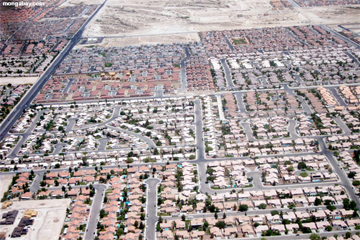 Las Vegas Sprawl. Photo by: Rhett A. Butler. |
Currently, humans are consuming the equivalent of one-and-a-half planet Earths every year, according to WWF’s Living Planet Report. Looking at renewable resources—from fish to forests and carbon to agriculture—the report shows just how far we have surpassed the sustainability of our world. By the time the global population is expected to stabilize at 9 (or maybe 10) billion people in 2050, a total 2.8 Earths will be necessary if ‘business as usual’ continues. In other words it would take the Earth’s resources nearly 3 years to recover from 1 year of human consumption. Not surprisingly, some consume a far bigger share than others: for example, if everyone on Earth consumed as much as the average American, global society would need 4.5 Earths today to live sustainably.
To understand the impact of humanity on the world’s ecosystems, one needs to keep in mind it is made up of two factors. The first is population: the more of us, the greater our collective impact. The other, though, is consumption: the more resources we each consume, the further we move away from true sustainability. This makes some more responsible than others. For example, according to a 2009 study, a child born in the US today will have a carbon footprint that is 7 times larger than a child born on the same day in China. But it gets worse: the American child’s carbon footprint would be 55 times larger than an Indian’s and 86 times larger than a Nigerian’s. Population multiplied by consumption is the important metric in comprehending our footprint. In addition, humans are also living longer. A sign of societal well-being, longer lives also means a more difficult time stabilizing population and a larger individual footprint.
Yet tackling global overpopulation does not require draconian methods or a mass human tragedy; in fact, lowering global population and consumption now would make such events less likely in the future. With around two of every five pregnancies unwanted, research has shown that the greatest way to slow population growth— eventually leading to a population plateau and a slow decline—is to empower women. Universal access to contraceptives, better education, and family planning are some of the best ways to combat an overcrowded planet. Reducing poverty and child mortality are additional goals that bring overall population growth down. It also wouldn’t hurt to build greater awareness around overpopulation and consumption—and make such issues topics of conservation, even in polite company.
Global issues in an age of 7 billion

Geometric patterns of deforestation in the Brazilian Amazon. Cattle ranching and soy are the biggest destroyers of forest in this part of the world. Photo by: Rhett A. Butler.
Food: Hunger is the issue most frequently brought up in conjunction with overpopulation (even though many others are just as pressing): how do we feed 7 billion people, let alone the 9 billion projected by 2050? According to the UN, a billion people in the world today don’t have enough food. However it’s not because the world doesn’t grow enough food, but because the food we produce is inequitably distributed. One third of all the world’s food is thrown out at one end of the agricultural chain or another: either spoiled by farmers, tossed out by merchants, or thrown in the garbage by consumers. Still, the FAO has estimated that food production will need to rise by 70 percent to supply the anticipated 9 billion. But how do we grow so much food without trashing the very environment that sustains agriculture? With quality arable land running out, there is a desperate need to grow more food on less land, while improving stewardship of resources such as water and soil. Experts continue to debate, sometimes fiercely, whether small-scale organic production is the only sustainable way forward, or whether industrial chemical-driven GMO farming is the answer.
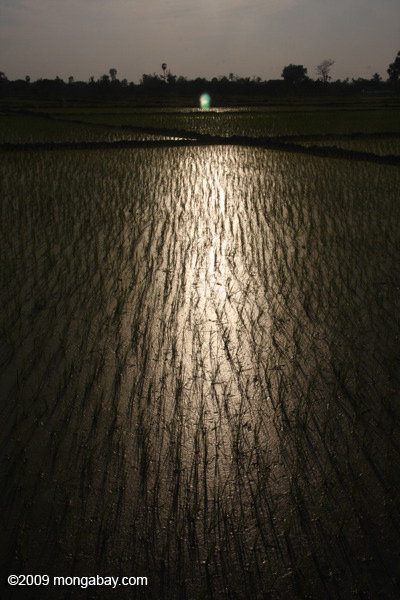 Rice field in Laos. Photo by: Rhett A. Butler. |
Water: Like food, access to fresh unpolluted water is becoming a rising concern on our crowded planet. Over 800 million people currently don’t have access to clean drinking water, while one in three people suffer from water scarcity, reports the WHO. And its not just the poor that face water problems: the American Southwest, where it is still common to see well-watered green lawns in the desert, is facing a water crisis largely due to decades of unsustainable and wasteful consumption. Experts warn that underground aquifers are running low all over the world, which will have a direct impact on crop production, since currently 70 percent of consumed water is used for agriculture. In the face of water issues, some nations are turning to desalination plants and taking their water from the sea. However, desalination is still prohibitively expensive for many, while climate change is expected to add greater pressure on water-scarce regions.
Mass extinction: More people consuming more resources means less and less for the millions of other species inhabiting our world. Many experts believe we are in the midst of mass extinction, with rates estimated at 100 and 1,000 times the background rate. The IUCN Red Lists says that 869 species have gone extinct since 1500 AD, yet this is a vast underestimation, considering the bulk of the world’s species have probably never been named, let alone evaluated. Expanding human population doesn’t just imperil big beloved species like rhinos, tigers, and elephants, but multitudes of species that perform essential services for humanity from clean water to soil health, and carbon sequestration to medicine. A collapse in biodiversity portends ecosystem collapse.
Oceans: In 2008 a report predicted that all wild fish stocks would collapse by 2048. This year, a landmark study predicted mass extinction in the oceans due to greenhouse gas emissions and pollution. Once believed to be superabundant, the world’s oceans are being plundered of wildlife (or overfished) at a rate never seen in human history. At the same time, ocean acidification from carbon emissions imperils the ocean’s most biodiverse ecosystem, coral reefs, and dead zones, areas starved of oxygen caused by nitrogen-rich pollution, are spreading worldwide. Such synergistic impacts mean the oceans of the future could be very different than those of today, and would likely provide far fewer resources, especially food, for future generations. Despite the dire warnings, fish stocks continue to be vigorously overfished, greenhouse gas emissions remain on the rise, and the oceans are still a dumping ground for much of society’s pollution.
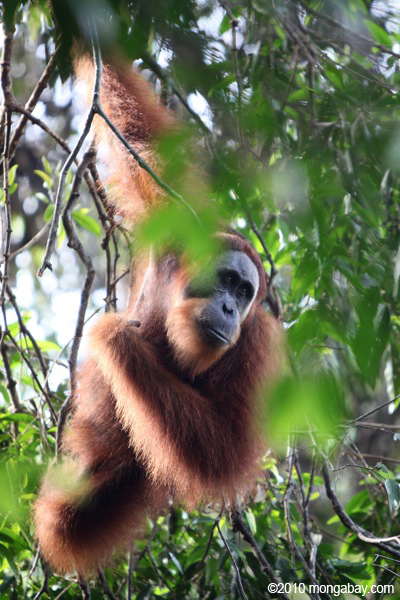 The Sumatran orangutan is considered Critically Endangered as forests continue to fall in Sumatra. Photo by: Rhett A. Butler. |
Deforestation: Every year over 10 million hectares of forest are lost (an area larger than Hungary) according to the FAO, and another 10 million hectares are degraded. Forests are cut for a variety of reasons, yet all of them connect to population and consumption with big agriculture and commodities playing the lead role. In South America the Amazon is being whittled away by cattle ranching, industrial soy farms, and mining. The rainforests of Indonesia and Malaysia are falling to plantations for paper and palm oil. Pressure by rural impoverished populations are diminishing forests in the Philippines, while foreign demand for high-end woods are degrading forests in Madagascar. Rising energy demands have led to forest destruction for biofuels, gas, oil, and hydropower. By some estimates half of the world’s intact tropical forests have been lost, and every year sees more destroyed. Besides harboring the majority of the world’s terrestrial biodiversity, forests store carbon, safeguard freshwater, produce vapor that leads to rain, and sustain many rural and indigenous populations.
Climate change: The 21st Century will be the century of climate change: a recent study predicted that regions in Canada, Asia, Europe, and North Africa will already see a rise of 2 degrees Celsius by 2030. Our warmer world will see rising sea levels, more extreme weather, higher frequency of droughts and floods, desertification, and biodiversity loss, generally creating a less stable and more unpredictable world. While rarely discussed, human population growth is invariably linked to greenhouse gas emissions, especially in wealthy and economically-rising powers: the wealthiest 7 percent produces half of the world’s emissions. More people and more consumption means more emissions, and until greenhouse gas emissions—whether from burning fossil fuels, raising food, or forest and peatlands destruction—becomes decoupled from consumption this will remain the case. In fact, efforts to slow population growth could have an important impact on mitigating global warming: a recent study found that slowing population growth could cut global emissions by 16-29 percent.
Disease: More humans could mean more disease, though evidence for such a connection thus far is often anecdotal and sometimes contradictory. However, crowded conditions, especially as the world’s mega-cities continue to grow, and rising pressures surrounding sanitation and health care, may increase or worsen outbreaks of disease. While recent fears of a devastating pandemic over avian flu and swine flu proved overblown, it does not mean rising populations may not play role in the next outbreak. Climate change is also expected to change the range of disease, possibly pushing many dangerous tropical diseases into once-temperate environments.
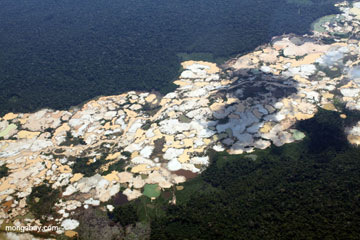 Aerial view of Amazon rainforest landscape scarred by open pit gold mines. Photo by: Rhett A. Butler. |
Resource scarcity: Overpopulation isn’t just taking a toll on renewable resources—such as forests and soils—but on non-renewable ones as well. Peak oil has become a popular term over the past decade for good reason. Since society has lagged in transitioning to a fossil fuel-free economy, energy companies are scouring ever-more distant places (the Amazon, the Arctic, and the deep ocean) for new fossil fuel sources, imperiling some of the last pristine environments. High energy prices are also contributing to higher food costs. Meanwhile, many of the world’s important manufacturing metals—such as steel, copper, platinum, nickel, and tin—are running low and becoming harder to get, pushing prices up and forcing mining companies, much like energy companies, into remoter places, risks be damned. In many parts of the world, even protected areas are no longer safe from mining, drilling, and exploitation for resources.
Economics: The world of economics is rarely looked at as an environmental problem, since many traditional economists appear quite willing to ignore the environment. Some have even forecast that the world’s economies will keep growing exponentially, with future generations far richer than we can imagine. But how can material wealth grow on a plundered finite world? Wealth, at least capital in resources, is dependent on the environment, and our environment—planet Earth—is both finite and increasingly plundered. Beyond the fact that there is a limited amount of oil, coal, gold, etc. in the world, there is only so far one can unwisely push renewable resources—such as fish in the sea, trees to log, and arable land—before they collapse. Sustainability means safeguarding renewable resources for future generations. But currently, waste and greed are plundering not just our non-renewable resources, but pushing our renewable ones to the brink. The rise of a global throwaway culture and conspicuous consumption has resulted in an economy based in part on collapsing environmental capital, creating what may be the ultimate bubble.
Poverty and wealth: Currently, over a third of the world’s population lives on less than $2 a day, while the top 1 percent globally holds 43 percent of the world’s wealth. Hundreds of millions don’t have access to enough food or clean water on a daily basis, while according to Forbes this year there are a record 1,210 billionaires possessing accumulated wealth of $4.5 trillion. As more people populate the planet, paradoxically the wealth disparity has been widening. Millions in developing countries are lacking the basics of human survival (food, water, shelter, and medicine) though their nations may be rich in natural resources. Meanwhile their resources, from forests to marine fish, are often unsustainably depleted for consumption abroad in wealthy nations.
Well-being: Even if we survive the environmental calamities brought on in part by overpopulation and overconsumption, even if we make it to 10 billion people and society is still humming along, how happy will we be? So many people crowding our small planet means the decline of some very human needs: privacy, wilderness, and hopefulness. It’s hard to imagine a world of beauty and happiness for our children, grandchildren, and great grandchildren if they only know gorillas and rhinos from images on the Internet, if they never have a chance to taste fresh seafood or experience true silence, if they can’t see the stars for all the light pollution or know the joy of an hour of solitude in the woods.

Herd of African buffalo and birds in the Okavango Delta. Photo by: Jeremy Hance.

Dani man in traditional battle array on the island of New Guinea. Once one of the remotest jungles on Earth, this island is seeing rapid change due to industrial-scale logging and mining. Photo by: Rhett A. Butler.
Exploitation of the ocean is leading to precipitous declines in marine life. Photo by: Rhett A. Butler.

Girl in a village in Madagascar: 70 percent of the Malagasy people suffer from malnutrition. Nearly half the population is under 14. Photo by: Rhett A. Butler.
CITATIONS:
Manoj Joshi, Ed Hawkins, Rowan Sutton, Jason Lowe and David Frame. Projections of when temperature change will exceed 2 °C above pre-industrial levels. Nature Climate Change. DOI: 10.1038/NCLIMATE1261. 2011.
Murtaugh, P.A., and M.G. Schlax. 2009. Reproduction and the carbon legacies of individuals. Global Environmental Change 19: 14-20.
O’Neill, B.C., Dalton, M., Fuchs, R., Jiang, L., Pachauri, S., Zigova, K. (2010) Global demographic trends and future carbon emissions. Proceedings of the National Academy of Sciences – USA 107 (41), 17521-17526.
Worm B, Barbier EB, Beaumont N, Duffy JE, Folke C, Halpern BS, Jackson JBC, Lotze HK, Micheli F, Palumbi SR, Sala E, Selkoe KA, Stachowicz JJ, Watson R. 2006. Impacts of Biodiversity Loss on Ocean Ecosystem Services. Science 314: 787-760.
Related articles

Vietnamese rhino goes extinct
(10/25/2011) In 2009 poachers shot and killed the world’s last Vietnamese rhinoceros (Rhinoceros sondaicus annamiticus), a subspecies of the Javan rhino, confirms a report from International Rhino Foundation (IRF) and the World Wide Fund for Nature (WWF). The Vietnamese rhino was the last Javan rhino to survive on the Asian mainland and the second subspecies to vanish, following the extinction of the Indian Javan rhino (rhinoceros sondaicus inermis). The Javan rhino is the world’s most imperiled rhino species with now only around 50 individuals surviving in a single park on its namesake island in Indonesia.
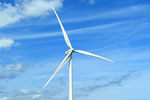
Sober up: world running out of time to keep planet from over-heating
(10/24/2011) If governments are to keep the pledge they made in Copenhagen to limit global warming within the ‘safe range’ of two degrees Celsius, they are running out of time, according to two sobering papers from Nature. One of the studies finds that if the world is to have a 66 percent chance of staying below a rise of two degrees Celsius, greenhouse gas emissions would need to peak in less than a decade and fall quickly thereafter. The other study predicts that pats of Europe, Asia, North Africa and Canada could see a rise beyond two degrees Celsius within just twenty years.
World’s largest beef company breaks commitment on avoiding Amazon deforestation
(10/19/2011) In a campaign launched in Italy on Wednesday, Greenpeace accused Brazilian beef giant JBS-Friboi of breaking its commitment to exclude cattle connected with illegal deforestation and slave labor from its supply chain.

Five ways to feed billions without trashing the planet
(10/13/2011) At the end of this month the UN predicts global population will hit 7 billion people, having doubled from 3.5 billion in less than 50 years. Yet even as the Earth hits this new milestone, one billion people do not have enough food; meanwhile the rapid expansion of agriculture is one of the leading causes of global environmental degradation, including greenhouse gas emissions, destruction of forests, marine pollution, mass extinction, water scarcity, and soil degradation. So, how do we feed the human population—which continues to rise and is expected to hit nine billion by 2050—while persevering the multitude of ecosystem services that supporting global food production? A new study in Nature proposes a five-point plan to this dilemma.
High gold price triggers rainforest devastation in Peru

(10/11/2011) As the price of gold inches upward on international markets, a dead zone is spreading across the southern Peruvian rain forest. Tourists flying to Manu or Tambopata, the crown jewels of the country’s Amazonian parks, get a jarring view of a muddy, cratered moonscape … and then another … and another in what the country boasts is its capital of biodiversity. While alluvial gold mining in the Amazon is probably older than the Incas, miners using motorized suction equipment, huge floating dredges and backhoes are plowing through the landscape on an unprecedented scale, leaving treeless scars visible from outer space. Sources close to the Peruvian Environment Ministry say the government is considering declaring an environmental emergency in the region, but emergency measures passed two years ago were not enough to contain the destruction, and some observers doubt that a new decree would have any more impact.

Meat consumption jumps 20 percent in last decade with super-sized environmental impacts
(10/11/2011) Meat consumption and production remains on the rise, according to a new report Worldwatch Institute, with large-scale environmental impacts especially linked to the spread of factory farming. According to the report, global meat production has tripled since 1970, and jumped by 20 percent since 2000 with consumption rising significantly faster than global population.
Poor in Madagascar see fish plundered for foreign consumption
(10/11/2011) A new study warns that overfishing could exacerbate poverty and political stability in one of the world’s poorest nations: Madagascar. According to the recent study by the University of British Columbia’s Sea Around Us Project and Malagasy NGO Blue Ventures, fish catches in the African island-nation from 1950 to 2008 are actually double the official numbers, with foreign wealthy nations currently taking half the haul.
UN calls for secure contraceptives as wildlife group hands out Endangered Species condoms
(10/06/2011) Sometime at the end of this month, the seventh billion person on Earth will be born: that’s seven billions mouths to feed, seven billion throats to water, and seven billion bodies to keep warm. But the population continues to rise: experts believe the global human population could hit 10 billion by 2050. A UN meeting last month said that to meet the needs of the world’s women, the developing world needs a secure supply of contraceptives and voluntary family planning initiatives.
Obama administration opens more of the Arctic to drilling
(10/05/2011) Nearly 500 Arctic oil and gas leases from the Bush administration have been restarted this week by the Obama administration. Known as Chukchi Lease 193, the various leases had been held up in court after environmental groups and indigenous groups challenged them, citing a significant lack of baseline information about the Chukchi Sea ecosystem. The Obama administration now says that many of the ecosystem gaps need not be filled, but Arctic indigenous and environmental groups disagree.
Fossil fuel subsidies going in the wrong direction?
(10/05/2011) In 2009, G20 nations committed to phasing out fossil fuel subsidies over the medium term, yet are further away today than they were two years ago from keeping the pledge. According to the International Energy Agency (IEA) fossil fuel subsidies rose by nearly $100 billion in the last year alone, from $312 billion in 2009 to $409 billion in 2010. The agency warned that subsidies could reach $660 billion by 2020 if governments don’t act on reform.
Satellite imagery confirms Dole destroying national park land for bananas
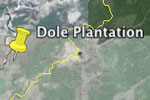
(10/04/2011) Environmental NGOs in Sri Lanka have accused US food giant Dole of illegally growing bananas in Somawathiya National Park, however Dole has denied the charge saying the land in question is ‘not in the [park]’. Mongabay.com has received the coordinates of the Dole plantation from an anonymous source in Sri Lanka familiar with the issue, and using Google Earth has found that the plantation in question is clearly inside park boundaries.
Putting people to work: restoring our ecosystems, sequestering carbon
(10/02/2011) President Obama’s sole focus of his September 8th speech to the United States Congress was job creation. He closed his speech by summoning an earlier time of promise: “President Kennedy once said, ‘ Our problems are man-made—therefore they can be solved by man. And man can be as big as he wants.’ These are difficult years for our country. But we are Americans. We are tougher than the times we live in, and we are bigger than our politics have been. So let’s meet the moment. Let’s get to work…” Inspiration is surely needed because in addition to the United States, where unemployment remains at about 9 percent, severe unemployment is found throughout the world, with Greece, Spain, and South Africa, for example, having 2011 summer unemployment rates at over 16, 20, and 25 percent, respectively.
Climate change shocker: Canada’s ice shelves halved in six years
(09/28/2011) After the Arctic sea ice extent hit its second lowest size on record this summer—or lowest (depending on the source)—comes another climate change shocker: in the past six years Canada’s millennia-old ice shelves have shed nearly half their size. One ice shelf—the Serson shelf—is almost entirely gone, while another—the Ward Hunt shelf—has split into two distinct shelves. The ice shelves have lost 3 billion tons in this year alone.
